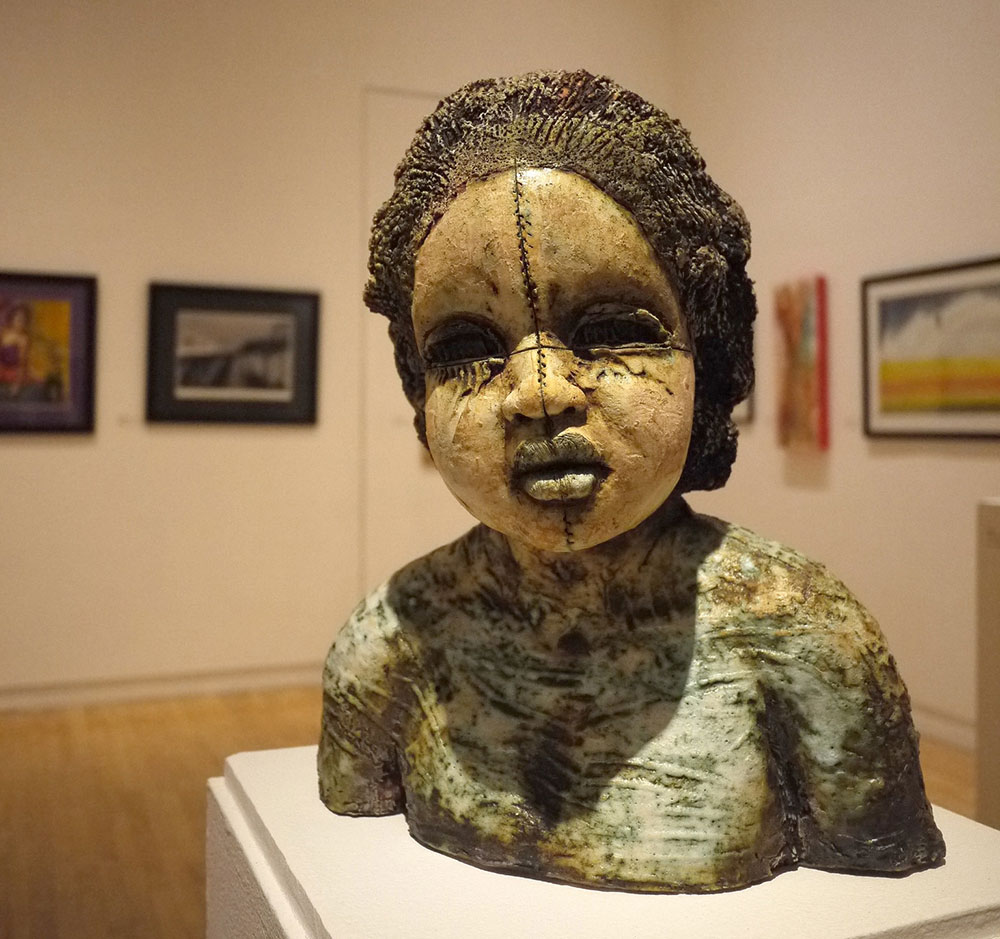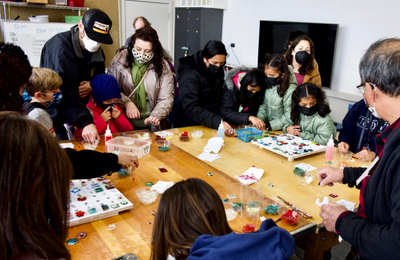Contra Costa Times: From Sociology Teacher to Sculpture Artist

We were thrilled when the Contra Costa Times wanted to feature artist Julee Richardson, whose work appears in the 19th Annual The Art of Living Black exhibition.
Julee is reflective of so many artists and creative people that exhibit in our galleries or take our classes — her diverse and varied background, her appetite for creativity and lifelong learning and her desire to show and talk about her work. We love the unique community of people who walk through our doors!
Don’t miss your chance to see Julee’s work; The Art of Living Black closes on Friday, February 27, 2015.
From sociology teacher to sculpture artist
Contra Costa Times, February 10, 2015
By Lou Fancher
Sculpture artist and sociology educator Julee Richardson is a scholar for life.
Studying the penetrating grooves that divide societies, closely observant of wedge-like pleats that fold harmony and disharmony into living histories or analyzing how society shapes people and people shape society, Richardson has carved an unusual place for herself in the world.
“As a gerontologist studying the social science of aging, you can’t help but learn,” the 70-year-old retired educator says in an interview.
Recently enrolled in a ceramics course at Los Medanos College where her art is on display in a students’ show, she is also preparing for an artist’s talk she’ll give from noon to 1:30 p.m. Saturday, Feb. 14 at the Richmond Art Center as part of the annual “The Art of Living Black” exhibit. Richardson is grateful a talent she largely abandoned for 20 years did not vanish.
“I feel blessed that the gift is still there,” the Brentwood resident says, about her work that consists primarily of busts, masks and human faces. “It dominates my days now.”
Growing up in the 1940s and 1950s in Niagara Falls, N.Y., Richardson says she was “ADHD before it had a name.” Her parents drugged her with art supplies, not medicine.
“The only time I was quiet was when I was doing art,” she recalls.
Her earliest efforts were doodles drawn in books, but majoring in art at State University College in Buffalo, N.Y., she worked in wood and stone. A two-year teaching stint in New York City taught her she didn’t like the lifestyle and a position working for American Field Service’s student exchange program brought her to San Francisco.
Raised by their parents to never fight, Richardson and her sister, Sara Tita, shared the first home of many they would own together. A master’s degree in gerontology from Holy Names College and a doctorate in Human Development and Aging from University of California, San Francisco, pushed Richardson’s hands-on art aside. Instead, she was “a freeway flyer, teaching all over the Bay Area” before settling at Chabot College in Hayward to teach sociology and coordinate the adult education program.
Along the way, she became a mother. (Proud to bursting, she says Michael James recently earned a managerial position with Aramark in Southern California.) She and her sister bought a 2,200-square foot home with plenty of land in the Oakland Hills.
Approaching retirement, Richardson enrolled in a ceramics course at Merritt College.
“One of my first pieces is a huge mask, broken up into bits. It’s a fracture sculpture. When you look at traditional African society it has the beauty of land, animals and culture. But it also has colonialism, disease, corruption, war. I don’t want to say ‘African-American.’ I want to say it’s the human experience,” she says, about this early piece, but also in general about the art she creates.
Fragmentation, perseverance, faith, beauty, struggle, pain, joy and even the “great leveler of society” she calls the drug epidemic sweeping communities of all races and ethnicities, do not make Richardson angry. Instead, they intensify her desire to pierce the bubble of fear, ignorance and harsh economics that marginalize African-American artists and other artists of color.
“Over the years, I’ve come to conclude that our racial habits are motivated by fear and economics. Some African-American artists are really good and would be competition,” Richardson says.
Girls, women in the Middle East, little boys who leave their homes in the morning as teenagers and never come back at night because of violence on city streets — these are society’s most vulnerable people, she says, broadening her circle of empathy beyond race or gender.
“The Unprotected” is an exquisitely powerful series of sculptures that share a “T-line” traveling from the crown of a figure’s head into a place deep under the chin.
“I kept it, accentuated it, and compare it to the crosshairs of a gun, as if you’ve looking through a scope,” Richardson says.
The simplicity of the sculptural gesture — a ragged vertical line — is characteristic of her soulful, people-filled work, which appears to tell a thousand stories while realistically being mute.
Richardson does her wet work in the Brentwood home she and her sister downsized to in June of 2014. She’s hoping to someday have a kiln in her studio, especially for the largest work that often weighs 40 pounds or more.
“I get a workout moving them, that’s certain,” she says, laughing.
Perhaps a supreme example of lifelong learning, Richardson says looking deeply into the human experience leaves her hopeful, bursting with energy and ideas for future work and mastering the elusive art of fine, last-touch, ceramic surfaces.
You can view the original posting here.
Tags: featured




